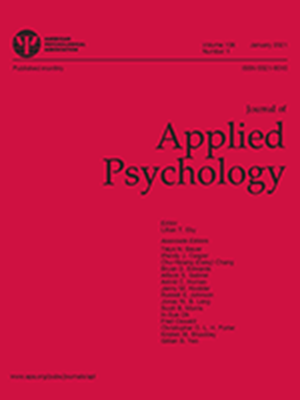Why do bootlickers get empowered more than boat-rockers? The effects of voice and helping on empowering leadership through threat and goal congruence perceptions.
IF 6.1
1区 心理学
Q1 MANAGEMENT
引用次数: 0
Abstract
As empowering leadership becomes increasingly needed in today's complex organizations, so does the need to understand what motivates leaders to give more (or less) empowering leadership to followers. We draw on threat rigidity theory to examine how followers' challenging and supportive voice differentially impact the extent to which leaders empower their followers. We argue that leaders perceive followers' challenging voice as more threatening and tend to empower them less, whereas leaders perceive followers' supportive voice as reflective of their goal congruence with followers, which motivates leaders to give them more empowering leadership. We further leverage threat rigidity theory to explain how leader-directed helping moderates the degree to which leaders respond to each type of voice in terms of threat and goal congruence perceptions and ultimately, with empowering leadership. We argue that leader-directed helping buffers challenging voice's positive effect on perceived threat and amplifies supportive voice's positive effect on leaders' perceptions of goal congruence with followers, which, subsequently, affects leaders' willingness to empower them. We mostly find support for these predictions in a time-lagged, multisource field study and a scenario-based experiment conducted across different countries and cultures. We discuss our theoretical contributions to the literature and practical implications for followers and leaders. (PsycInfo Database Record (c) 2025 APA, all rights reserved).为什么马屁精比摇船者更有权力?通过威胁和目标一致性感知,声音和帮助对授权领导的影响。
在当今复杂的组织中,越来越需要授权型领导,因此也需要了解是什么促使领导者给下属更多(或更少)授权型领导。我们利用威胁刚性理论来研究追随者的挑战和支持的声音如何不同地影响领导者赋予追随者权力的程度。我们认为,领导者认为追随者的挑战声音更具威胁性,倾向于减少授权,而领导者认为追随者的支持声音反映了他们与追随者的目标一致性,这促使领导者给予他们更多的授权领导。我们进一步利用威胁刚性理论来解释领导导向的帮助如何调节领导者在威胁和目标一致性感知方面对每种声音的反应程度,并最终通过授权领导。我们认为,领导导向的帮助缓冲了挑战性声音对感知威胁的积极影响,放大了支持性声音对领导者与下属目标一致性感知的积极影响,从而影响了领导者赋予下属权力的意愿。我们在一项时间滞后的、多来源的实地研究和一项在不同国家和文化中进行的基于场景的实验中发现了对这些预测的支持。我们讨论了我们对文献的理论贡献以及对追随者和领导者的实际意义。(PsycInfo Database Record (c) 2025 APA,版权所有)。
本文章由计算机程序翻译,如有差异,请以英文原文为准。
求助全文
约1分钟内获得全文
求助全文
来源期刊

Journal of Applied Psychology
Multiple-
CiteScore
17.60
自引率
6.10%
发文量
175
期刊介绍:
The Journal of Applied Psychology® focuses on publishing original investigations that contribute new knowledge and understanding to fields of applied psychology (excluding clinical and applied experimental or human factors, which are better suited for other APA journals). The journal primarily considers empirical and theoretical investigations that enhance understanding of cognitive, motivational, affective, and behavioral psychological phenomena in work and organizational settings. These phenomena can occur at individual, group, organizational, or cultural levels, and in various work settings such as business, education, training, health, service, government, or military institutions. The journal welcomes submissions from both public and private sector organizations, for-profit or nonprofit. It publishes several types of articles, including:
1.Rigorously conducted empirical investigations that expand conceptual understanding (original investigations or meta-analyses).
2.Theory development articles and integrative conceptual reviews that synthesize literature and generate new theories on psychological phenomena to stimulate novel research.
3.Rigorously conducted qualitative research on phenomena that are challenging to capture with quantitative methods or require inductive theory building.
 求助内容:
求助内容: 应助结果提醒方式:
应助结果提醒方式:


